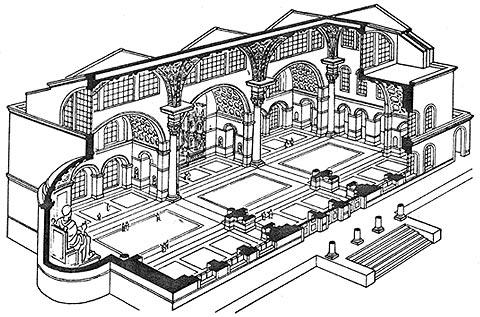The other end of the Forum is also marked by an Arc, the Arc of Titus. It was erected by Domitian in 81 A.D. to commemorate the victory of Vespasian and Titus over Jerusalem.
The other end of the Forum is also marked by an Arc, the Arc of Titus. It was erected by Domitian in 81 A.D. to commemorate the victory of Vespasian and Titus over Jerusalem.
It is every bit as detailed as the Arc on the other end of the Via Sacra. This relief depicts Titus' victory.
The enormous Basilica of Maxentius dominates this side of the forum. It was started by Maxentius in 308 A.D., and completed by Constantine in 313 A.D. after he defeated Maxentius in the battle of the Milvian Bridge.
The remaining part of the Basilica stands 85 feet tall. This was the smaller part of the original building, which at its highest point was over 150 feet tall.

One can still see the remains of the ceiling supports, a testament to the endurance of Roman concrete.
The fence and the people in the foreground lend a sense of scale.
There were probably enormous statues of the gods in the alcoves along the back wall of the basilia. Pieces of the enormous statue of Constantine were found on the other end of the basilica, and probably occupied an alcove on the West side of the building, as pictured in the drawing above.
The ceiling of the arches remains intact in many places. Note the octagonal pattern in the roof – it is one we saw repeated (although usually much smaller) in many places in Rome.
The bronze tiles which once covered the roof were taken in the 7th century to tile the roof of Saint Peter's.
Doors to the Round Temple of Romulus. Despite its auspicious name, this temple was probably built in dedication to the son of Maxentius, Valerius Romulus, in 307 A.D. It probably has little or nothing to do with Romulus, the legendary founder of Rome. It has survived nearly intact because it was adopted as an atrium of the Church of St. Cosma and St. Damiano in the 6th century. The bronze door is the original, from the late Imperial age.